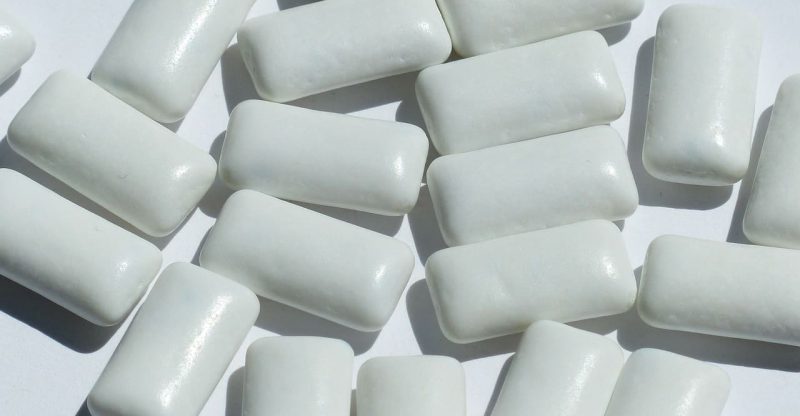What is Sorbitol (E420) in Food? Uses, Safety and Side Effects

What is Sorbitol | Health benefits | Uses | Safety | Side effects | FAQs
Sorbitol, a sugar alcohol (or polyol) primarily used as a bulk sweetener and humectant in food categories such as bakery, candy and chewing gum. It shares the biggest market among all sugar alcohols. The European food additive number is E420. This ingredient is an isomer of another sugar alcohol – mannitol.
What is Sorbitol?
A type of carbohydrate which is different with sugar and other carbohydrates as it is non-cariogenic (tooth friendly). With two – thirds of calories of sugar, 60% as sweet as sugar, with a cool effect and a low glycemic index which may be helpful to people with diabetes.
Sorbitol is commercially produced to reduce the intake of sugar & calories and we can commonly find it in sugar-free chewing gum, candy, baked goods, chocolates and frozen desserts.
- Two types in market
- Natural sources in fruits
- Is it a sugar or reducing sugar?
- What is the relationship with alcohol?
- What is it made of?
- What is it made from?
- How is it made?
Two Types in Market
It is available in both crystalline (commonly powder) and solution form (commonly sorbitol 70 solution) which is also called sorbitol syrup.
Natural Sources
Sorbitol is a naturally occurring ingredient that can be found in fruits like berries, apples, pears, peaches, prunes and apricots.
Is it a Sugar Or Reducing Sugar?
Neither, it is not a sugar or reducing sugar as the aldehyde groups (-CHO) on it have been reduced to hydroxyl groups (-CH2OH) and does not contribute to the Maillard reaction.
What is its Relationship with Alcohol?
Together with xylitol, mannitol, maltitol, isomalt, lactitol and erythritol, they all belong to the category of sugar alcohols.
Their chemical structure is partially similar to sugar and partially resembles alcohol.
Some consumers may mistake a sugar alcohol for the combination of sugar and alcohol, but it does not contain sugar or ethanol and has nothing to do with them.
What is it Made of?
Its crystalline form is mainly (not less than 91%) composed of D-sorbitol, also along with small compositions of mannitol, iditol and maltitol.
What is it Made From?
Mainly produced from corn starch. Also can be obtained from other starch sources, such as tapioca, potato and wheat.
How is it Made?
It is commercially produced by the reduction reaction (or hydrogenation) of glucose. Aldehyde groups of glucose are reduced to hydroxyl groups after hydrogenation reduction.
The brief manufacturing process is as follows: the starch is totally broken down to produce glucose by the enzyme.
Then, the addition of hydrogen to convert glucose to sorbitol with the assistant of a metal catalyst.
Health Benefits
When used in food and drink, there are two major health benefits for our body proven by EFSA compared with table sugar, the reduction in the rise of post-prandial blood glucose and the insulin response and the maintenance of tooth mineralisation by decreasing tooth demineralisation. (1)
Blood Glucose
Sorbitol is slowly absorbed and only leads to a small and insignificant increase in the blood glucose concentration. So it can be a sweetener in the application of diabetics’ food.
Oral Health
Sugar alcohols are noncariogenic carbohydrate sweeteners which do not promote dental caries and can be used to substitute sucrose and corn sweeteners in chewing gums and confectioneries. (2)
Sugar alcohols are slowly metabolized by bacteria in the mouth and produce less acid at a slower rate than that of sucrose and other fermentable carbohydrates. It is the acid that will form dental plaque and increase the risk of tooth decay.
Food with sugar alcohols will not cause the loss of important minerals from tooth enamel and is useful in not promoting dental caries.
Specification
| Other Names |
|
| CAS Number | 50-70-4 |
| Chemical formula | C6H14O6 |
| Molecular Weight | 182.17 |
| Melting point | 88 to 102 °C |
Properties
Appearance
- Solid: White hygroscopic powder, crystalline powder, flakes or granular.
- Solution: Clear and colourless aqueous solution.
Sweetness
Approximately 60% sweet as table sugar, along with a cool effect and pleasant taste.
Glycemic Index
It has a low glycemic index – 9. That’s to say, it raises blood sugar but is very mild compared with sugar and is safe for diabetics. (3)
Calorie
It is a nutritive sweetener as it provides caloric value of 2.6 kcal/g which is lower than that of carbohydrate (not polyols) which is 4 kcal/g (4). So it can be used in calorie reduction products, e.g. weight loss products.
Solubility
Very soluble in water, slightly soluble in ethanol.
Structure

From Wikipedia
What are the Uses?
Food grade sorbitol is mainly used as a sugar substitute to provide sweetness in candies, chewing gum, gummy bears and mints. It can also function as a moisturizer to maintain the water and freshness of baked goods during the storage which are easy to become dry or harden.
In toothpaste, it prevents the loss of water and traps the water (5).
It is also used in cosmetics and pharmaceuticals.
Food
Humectant
Ingredients that can absorb a certain amount of water from the air can be used as a humectant. The polyhydroxy structure of sorbitol enables it to combine with water, thereby maintaining moisture, controlling crystallization, and improving the softness in food.
At the same time, it has the ability to increase volume, control viscosity and texture. It is commonly used as a humectant in bread and cakes.
Sweetener
Candy and gum are often contains with sorbitol which is mainly used as a sweetener to replace sugar. Usually used in combination with fructose.
Others
In seafood as a humectant and cryoprotectant. In beverage, sorbitol can chelate metal ions and reduce turbidity. It is also used a raw material to manufacture following food additives:
- Vitamin C
- Polydextrose
- Sorbitol esters (E491, E492, E493, E494, E495), a category of food emulsifier.
- Polysorbates (E432, E433, E434, E435, E436), a category of food emulsifier synthesized by the reaction between sorbitan (dehydration of sorbitol), fatty acids and ethylene oxide. It can prevent starch retrogradation and improve processing in bread, and can also be used in cake, ice cream and soy milk production.
Cosmetics
Per the “European Commission database for information on cosmetic substances and ingredients”, it acts as an absorbent, binding, emulsion stabilising, film forming, hair conditioning, skin conditioning in cosmetic and personal care products (6). Commonly in soap, skin care and hair products.
Toothpaste
It functions as a moistener, plasticizing agent and a viscous squeeze carrier in toothpastes and mouthwash products. It also imparts a cool, fragrant taste and provides better clarity than glycerol (also a humectant).
Pharmaceutical
It can be used as a filler/binder/plasticizing agent or a bulk sweetener to mask bitter taste in the medical formulations of powder, premixes, granular, tablets, and syrup.
Is Sorbitol Safe to Eat?
Yes, its safety when used as a food additive has been approved by the U.S. Food and Drug Administration (FDA), European Food Safety Authority (EFSA), Joint FAO/WHO Expert Committee on Food Additives (JECFA), as well as other authorities.
FDA
It is GENERALLY RECOGNIZED AS SAFE (GRAS) and can be used as an humectant, nutritive sweetener, sequestrant, stabilizer and and texturizer in food.
The following are the approved food categories with the max usage (7):
- Hard candy and cough drops: 99%
- Soft candy: 98%
- Chewing gum: 75%
- Nonstandardized jams and jellies, baked goods and baking mixes: 30%
- Frozen dairy desserts and mixes: 17%
- Other foods: 12%
EFSA
Sorbitol E420(i) and sorbitol syrup E420(ii) are listed in Commission Regulation (EU) No 231/2012 as an authorised food additive and categorized as “sweeteners” (8).
Authorised Uses And Use Levels
Most of its application is listed in Group I with the usage of “quantum satis”. It can also be used as a carrier in all food additives and nutrients for the purpose other than sweetening. (9)
UK Food Standards Agency
Categorized in “Sweeteners” (10)
Food Standards Australia New Zealand
In Australia and New Zealand are all with the code number 420. (11)
JECFA
Functional Class: food additives, humectant, sweetener, stabilizer, texturizer, sequestrant, thickener. (12) (13)
Acceptable daily intake: “ADI not specific” set in 1982 and there is no need for a separate evaluation and ADI establishment for sorbitol syrup in the 2018 evaluation. (14) (15)
What are the Possible Side Effects?
It is common that sometimes consumers have questions whether sorbitol is bad for our health and what are the possible side effects. It is generally considered safe but some people may be allergic to it and large amounts may cause laxative problems.
Allergy
It may trigger some sensitive symptoms such as headaches, diarrhea, nausea, and other reactions to people who are allergic to it.
Large amount
Too much consumption may have a laxative effect and may cause gastrointestinal intolerance, e.g. gas, bloating and diarrhea.
Is Sorbitol Safe for Dogs and Cats?
It serves as a moisture-retention agent in the various formulations of pet food, e.g. dog and cats food. Sorbitol is generally considered safe while xylitol may do bad to pets.
Sorbitol metabolism
As aldehyde groups (-CHO) have been reduced to alcohol groups (-CH2OH), that’s why its absorption and metabolism is more slowly than glucose in our body.
Is it Safe for Pregnant?
Yes, it is generally safe but better consult your doctor in the condition of use.
Frequently asked questions
Is it Natural?
No, it is commercially made from hydrogenation of glucose although sorbitol occurs naturally in fruits, however, the extraction from fruits is not a viable production method.
Is it an Artificial Sweetener?
No, artificial sweeteners commonly refer to aspartame, sucralose, neotame, saccharin, and acesulfame k. When compared sorbitol with these sweeteners, the difference relies on calories and sweetness. Artificial sweeteners generally produce almost 0 calorie and are more sweet than sorbitol.
Is it A Preservative?
No, it can help the preservation of food with its humectant property but not a preservative which can inhibit the microbial growth, such as sodium benzoate and potassium sorbate.
Is it Halal?
Yes, it is generally recognised as halal as it is permitted under the Islamic Law and fulfill the conditions of Halal. And we can find some manufacturers certificated with MUI halal.
Is it Kosher?
Yes, it is kosher pareve. It meets all the “kashruth” requirements and can be certified as kosher.
Is it Vegan?
Yes, it is vegan friendly as derived from starch and the manufacturing process without the use of animal matter or products derived from animal origin. So it is suitable to add it in the diet of vegetarians.
Is it Gluten Free?
Yes, it is a common ingredient in both gluten-free and gluten-containing food labels. Sorbitol complies with the FDA’s definition of gluten free, that it does not contain wheat, rye, barley, or crossbreeds of these grains. And it is generally considered safe for people with celiac disease.
Conclusion
Now I think you may have a knowledge of the sugar alcohol – sorbitol (E420), from its two types: powder and syrup, fruit sources, production process, health benefits compared with sugar, uses as a sweetener and humectant in food, approved safety and possible side effects. Also, you may be clear with some common FAQs such as is it gluten free, synthetic or natural.
What kinds of food packaging have you found this additive in? Let me know in the comments.



it is absolutely not safe when ethylene oxid is used in the prosess manufactuting it.ethylene oxid is a carsinom and there is no safe levels for humans.